Ever wondered why a Guitar sounds the way it does? What are the factors that affect the sound of a guitar?
Let’s discuss it today.
Get ready for a backstage pass into the world of strings, bridges, and pickups that shape the soul-stirring sound of your favorite six-string companion. 🚀
Whether you’re a guitar rookie or a seasoned strummer, this blog is your ticket to understanding the magic behind every note. 🎶
Let’s crank up the volume and dive into the heart of what makes your guitar sing! 🤟
#LeagueOfGuitars #GuitarSoundMagic
The 10-Factor Analysis for Guitar Sound
When it comes to the Sound Quality of a Guitar, I’d like to do something called a 10-factor analysis.
Each of these Ten Factors will affect the overall Sound Quality of your guitar.
So, do not compromise on these.
Below are the ten things you should thoroughly inspect when buying a Guitar.
1. Softwood vs Hardwood
When it comes to guitars, two main types of wood are used to make the body and neck: softwoods and hardwoods. Each type of wood has its unique characteristics and can have an impact on the guitar’s sound and playability.
Softwoods, as the name suggests, are softer and less dense than hardwoods. Some examples of softwoods used in guitars include spruce and cedar.
Softwoods are often used in acoustic guitars because they are lightweight and resonate well, which can give the guitar a bright, clear tone.
However, because they are softer, they can also be more prone to dings and scratches.
Hardwoods are denser and more durable than softwoods. Some examples of hardwoods used in guitars include mahogany and maple.
Hardwoods are often used in electric guitars because they can provide a more focused, sustain-heavy sound. They are also more resistant to wear and tear, which can make them a good choice for touring musicians.
2. Tonewood Comparison

Tonewood is an important factor that affects the sound of a guitar.
Below are some popular tone woods used in guitars, divided into categories based on where they are used.
Fretboard 🎸:
- Rosewood 🌹: Rosewood is a dark, dense hardwood that is often used for the fretboard of acoustic and electric guitars. It has a warm, mellow tone and is durable and smooth to play on.
- Ebony 🖤: Ebony is a dense hardwood that is often used for the fretboard of electric and acoustic guitars. It has a smooth, silky feel and a bright, snappy tone. It’s great for styles such as jazz and blues.
Neck 🎸:
- Mahogany 🌳: Mahogany is often used for the body and neck of electric guitars. It has a warm, rich tone with plenty of sustain. It’s great for classic rock and blues.
- Maple 🍁: Maple is a bright, dense hardwood that is often used for the body and neck of electric guitars. It has a snappy, articulate tone with plenty of attacks. It’s great for styles that require a lot of precision, such as jazz and country.
Top 🎸:
- Spruce 🌲: Spruce is a softwood that is often used for the top of acoustic guitars. It has a bright, clear tone with plenty of projection. It’s great for fingerstyle playing and flatpicking.
- Cedar 🌳: Cedar is a softwood that is often used for the top of acoustic guitars. It has a warm, mellow tone with a strong midrange. It’s great for fingerstyle playing and strumming.
Body and sides 🎸:
- Koa 🌺: Koa is a tropical hardwood that is often used for the body and sides of acoustic guitars. It has a warm, balanced tone with a strong midrange. It’s great for strumming and fingerstyle playing.
- Walnut 🌰: Walnut is a hardwood that is often used for the body and sides of electric and acoustic guitars. It has a warm, punchy tone with plenty of midranges. It’s great for blues and rock.
- Basswood 🌳: Basswood is a relatively soft, lightweight hardwood that is often used for the body of electric guitars. It has a neutral, balanced tone with good sustain and a wide frequency range. It’s great for a wide range of styles, from clean to heavy and distorted.
- Alder 🌳: Alder is a lightweight hardwood that is often used for the body of electric guitars. It has a bright, balanced tone with good sustain and a strong midrange. Alder is also relatively affordable and easy to work with.
Apart from these woods, Maple 🍁 and Mahogany 🌳are also widely used in Guitar Bodies and Sides.
Comparing Different Top Woods
The top of an acoustic guitar is one of the most important factors in determining its tone.
A solid top guitar is made from a single, solid piece of wood, while a laminate top guitar is made from several layers of wood that have been glued together.
Solid top guitars tend to have a richer, fuller sound with more sustain, while laminate top guitars tend to have a brighter, more focused sound that can be great for strumming and fingerpicking.
Solid top guitars are usually more expensive but can be worth the investment if you’re looking for a higher-quality instrument.
On an electric guitar, the choice of wood for the top is less important than on an acoustic guitar.
Flamed maple tops are made from a single, solid piece of wood that has a distinctive “flame” pattern, and are often used on high-end electric guitars for their visual appeal.
Maple veneers are thin slices of maple that are glued to the top of a guitar to give it a similar look and feel to a solid maple top but at a lower cost.
Some electric guitars don’t have a maple top at all, and instead use other woods like mahogany, alder, or ash.
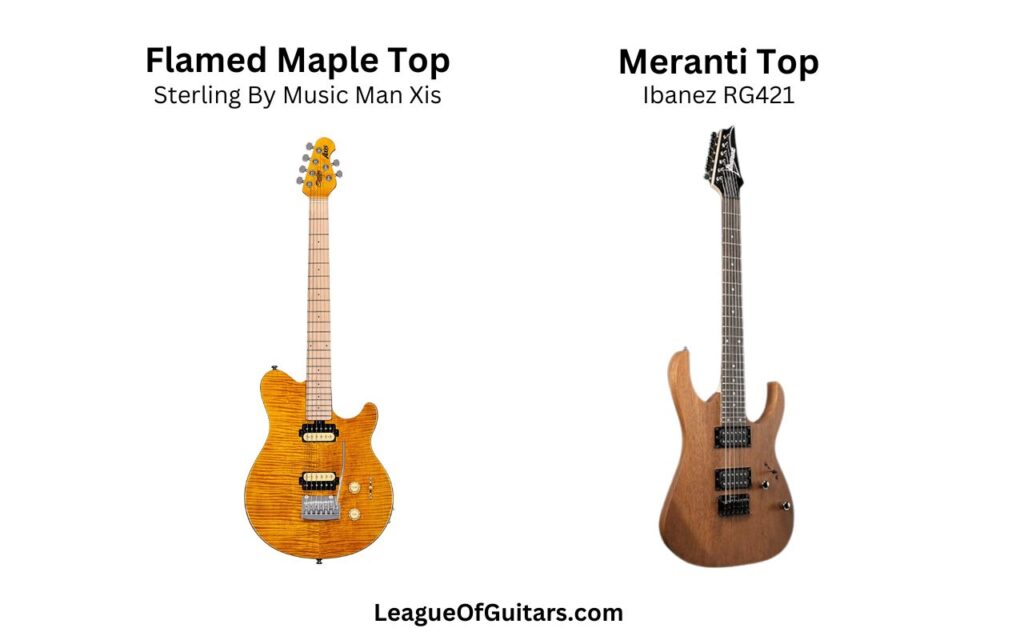
3. Strings
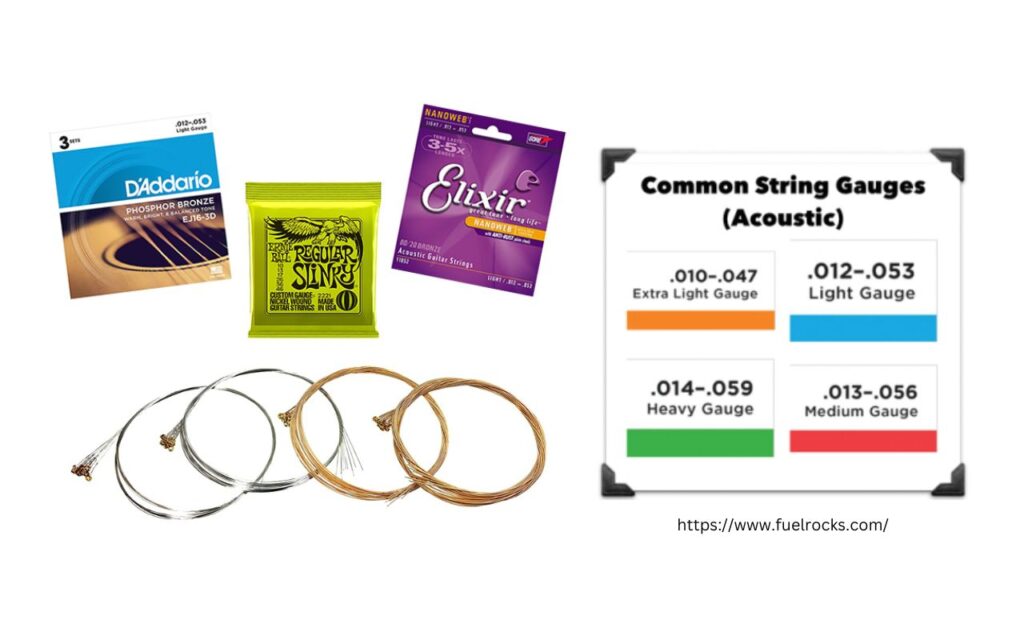
🎸🎶 Strings are like the “voice” of your guitar – they produce the sound that you hear when you play.
There are a few key factors that can affect how your guitar sounds based on the strings you choose:
- Gauge 🎚️:
The gauge, or thickness, of your strings, can affect the overall tone of your guitar. Thicker strings tend to produce a richer, fuller sound, while lighter strings can be brighter and easier to play.
Choosing the right gauge for your playing style and guitar can help you achieve the sound you’re looking for.
A common gauge for acoustic guitar strings is “light” or “medium-light,” which typically ranges from .012 to .054 inches in diameter. For electric guitar strings, the “light” gauge is usually around .010-.046 inches. - Material 🌳:
Strings can be made from a variety of materials, including nickel, bronze, and steel.
Different materials can produce different tones and levels of sustain.
For example, bronze strings are often used on acoustic guitars for their warm, mellow sound, while steel strings are popular for their bright, punchy sound.
Bronze: Bright, warm, and well-balanced. Popular for acoustic guitar.
Phosphor Bronze: Similar to bronze but with a slightly darker tone and longer sustain. Also popular for acoustic guitar.
Nickel: Smooth and warm. Often used on electric guitars.
Stainless Steel: Bright and punchy. Also used on electric guitars. - Coating 🧥:
Some strings are coated with a thin layer of material to help protect them from corrosion and prolong their lifespan. Coated strings can also produce a slightly different tone than uncoated strings, so it’s worth experimenting to see what you prefer.
Some popular coated string brands include Elixir and D’Addario EXP. Coated strings tend to have a slightly longer lifespan than uncoated strings. - Brand 🏷️:
Some brands are known for producing strings with certain tonal characteristics, so it’s worth trying out a few different brands to see what works best for you.
D’Addario: A well-known and widely-used brand that offers a variety of string options for acoustic and electric guitars.
Martin: Known for their high-quality acoustic guitar strings.
Ernie Ball: Popular among electric guitar players, with a focus on rock and metal styles.
Fender: Another popular brand for electric guitar strings.
4. Pickups
Pickups are essentially little magnets that sit underneath the strings of your guitar and capture the sound vibrations. They’re a big part of what makes electric guitars sound so different from acoustic guitars!
First up, let’s talk about single-coil pickups. These pickups are known for their bright, clear, and jangly sound, and are often used in genres like country and surf rock. Some popular single-coil pickup brands include Fender and Seymour Duncan. 🤠🏄♂️
Humbucker pickups are known for their thicker, more full-bodied sound, and are often used in genres like rock and metal. Some popular humbucker pickup brands include Gibson, EMG, and DiMarzio. 🤘🎸
But that’s not all! There are also P90 pickups, which are somewhere in between single-coils and humbuckers in terms of tone.
And then, there are also active pickups, which require a battery and offer a very high output and a more compressed sound. EMG is a popular brand that makes active pickups. ⚡️
Some guitars come with pickups already installed, while others allow you to swap out pickups for different sounds. Just remember that different pickups will give you different tonal options, so don’t be afraid to experiment! 🤘
5. Bridge
As mentioned in earlier sections, The bridge is an essential part of your guitar that holds the strings in place and helps transmit the string vibrations to the body of the guitar. There are many different types of bridges.
A traditional fixed bridge is often found on Telecasters. These bridges are simple and straightforward and are known for producing a bright, crisp sound.
They offer excellent tuning stability, which is important if you want to keep your guitar in tune for extended periods of time! 🔧🎼
Another type of bridge is the floating tremolo, which can be found on guitars like the Fender Stratocaster and the Ibanez RG.
These bridges allow you to bend notes and create subtle vibrato effects, which can add a lot of depth and expression to your playing. However, they can also make tuning more challenging, so it’s important to be aware of that! 🎸🌊
Some other types of bridges include the Tune-O-Matic, which is often found on Gibson-style guitars and produces a warm, fat tone, and the Floyd Rose, which is popular among heavy metal players and allows for extreme dive bombs and other wild tremolo effects. 🤘🔥
Tip: As a Beginner, Try not to buy a Guitar with a Floating or Floyd Rose bridge. It is difficult to manage if you are inexperienced.
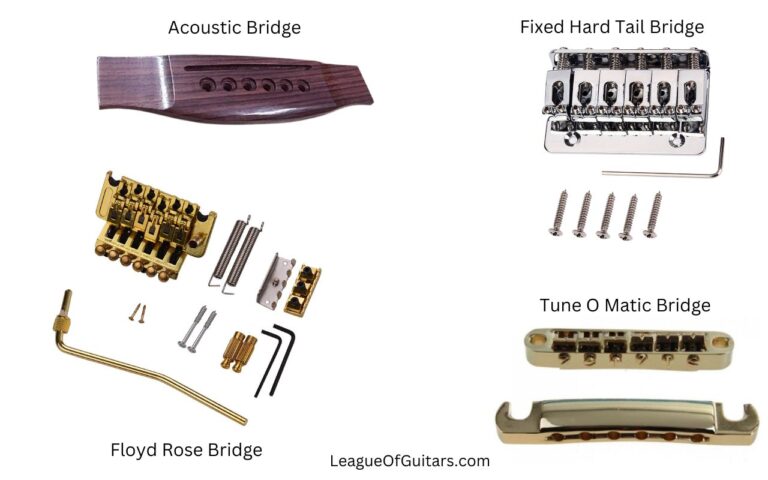
6. Nut
The guitar nut is responsible for keeping the strings in place and spacing them out evenly. The nut is also an essential part of achieving proper intonation on your guitar! 🤔
Intonation refers to the ability of your guitar to play in tune all the way up and down the fretboard. If your intonation is off, it can make your guitar sound out of tune, even if you’re playing the right notes! 🙉
To ensure proper intonation, your guitar’s nut needs to be cut and filed to the correct depth and spacing for the gauge of strings you’re using. This will ensure that each string rings out at the correct pitch when played open and that the notes are properly spaced out as you move up the fretboard. 🔧🎼
There are many different materials that guitar nuts can be made from, including bone, plastic, and metal.

If you’re experiencing intonation issues on your guitar, it may be time to have your nut checked and possibly replaced. A good guitar tech or luthier can help you diagnose any issues and make the necessary adjustments to ensure your guitar is playing in tune all the way up and down the neck! 🔍👨🔧
How to Check For a Damaged Nut?
To ensure that your guitar’s nut is okay, you can perform some simple checks and adjustments:
- Check for any visible cracks, chips, or other damage to the nut. If you notice any damage, it may need to be replaced.
- Make sure that the strings are properly seated in the nut slots and that there is no excess space between the string and the nut. If the strings are not seated correctly, it can cause tuning and intonation problems.
- Use a tuner to check the intonation of each string at the open position and at the 12th fret. If there are any tuning discrepancies, it could be a sign that the nut needs to be adjusted or replaced.
7. Frets
Frets are thin metal wires that are inserted into the fingerboard of your guitar. They help you to precisely and consistently play notes, chords, and scales across the neck. Without frets, playing guitar would be much more challenging! 😬
Larger frets make it easier to bend strings and play vibrato, while smaller frets offer more precise intonation.
It’s all about finding the fret size that works best for your playing style! 🤘
Over time, the frets on your guitar can be worn down, leading to buzzing or intonation issues.
When this happens, it’s important to have your frets checked and, if necessary, replaced by a professional guitar tech or luthier.
They can also level and crown your frets, ensuring that they are even and playing in tune all the way up and down the neck. 🔧👨🔧
Fret maintenance is also essential for keeping your guitar sounding its best.
You can clean your frets with a soft cloth and some guitar cleaner to remove any buildup or grime.
And if you’re playing regularly, it’s a good idea to have your frets checked and maintained at least once a year. 📅
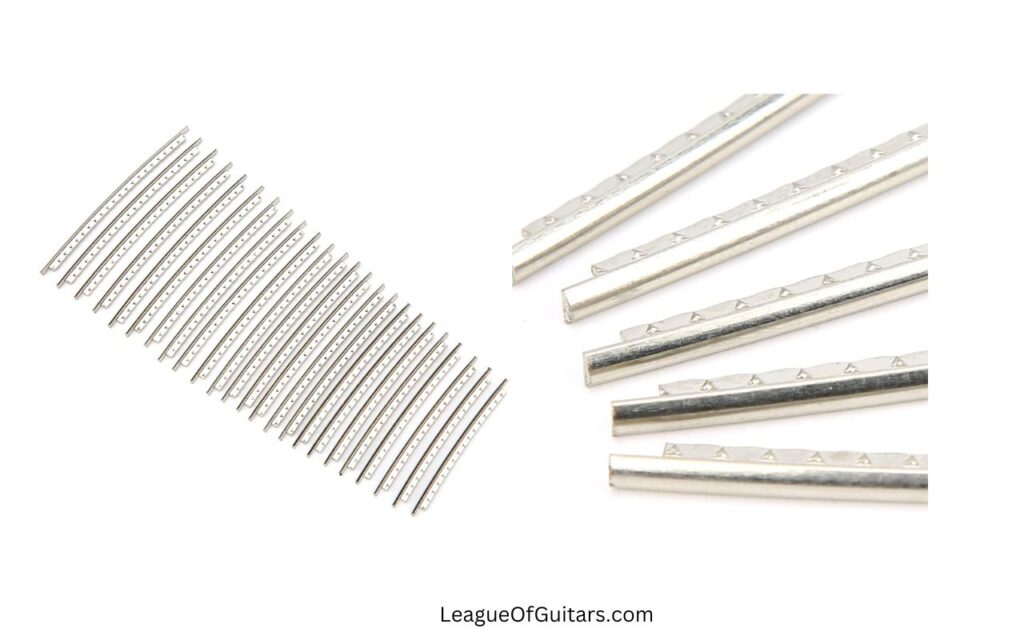
8. Neck Joints & Scale Length
When it comes to neck joints, there are a few different types that you might come across on an acoustic guitar, including bolt-on, set neck, and neck-through.
A bolt-on neck joint produces a brighter, more articulate sound because it allows for greater energy transfer between the neck and body.
A set neck or neck-through joint produces a warmer, more resonant tone because the neck and body are more tightly integrated.
Scale length is another important factor to consider when it comes to the sound of a guitar.
Scale length refers to the length of the strings from the nut to the bridge and can have a significant impact on the overall tone and feel of the instrument.
Generally speaking, a longer scale length (e.g. 25.5 inches) will result in more tension on the strings, which can produce a brighter, more focused sound with greater sustain.
A shorter scale length (e.g. 24 inches) may produce a warmer, more mellow sound with less sustain.
If you’re a beginner or intermediate player looking for an affordable guitar, a bolt-on neck joint can be a good choice. It’s easy to adjust and repair.
If you’re an experienced player looking for a higher-end instrument with better sustain and resonance, a set-neck or neck-through joint may be a better option.
As for scale length, if you play music that requires a lot of string bending, a shorter scale length can make it easier to achieve the desired sound. For blues or rock, a guitar with a shorter scale length is a perfect choice.
If you’re into fingerstyle playing or classical music, a longer scale length can produce a more focused sound that’s well-suited to those styles.
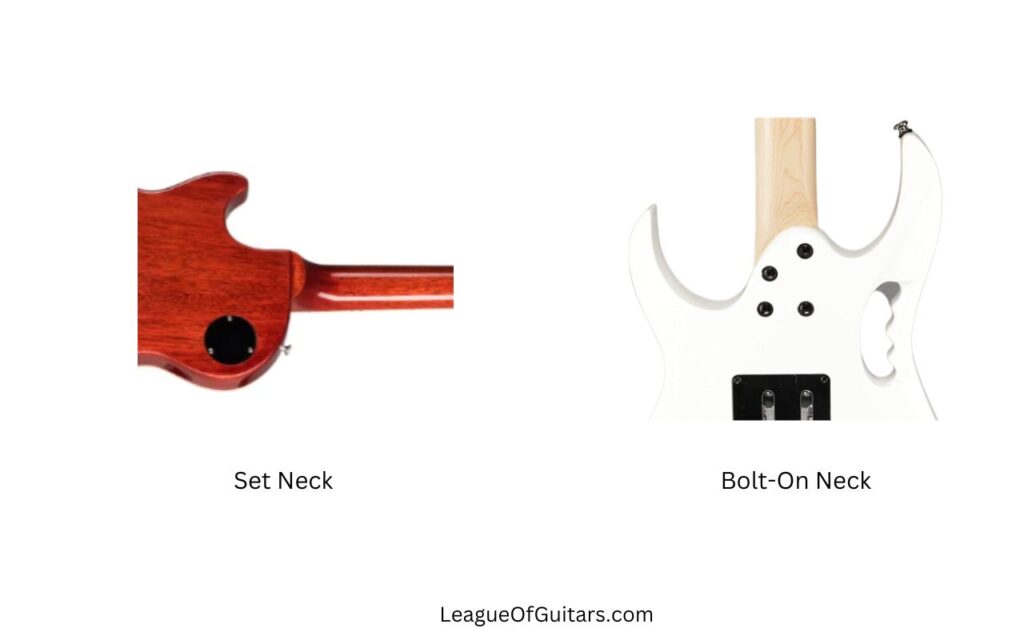
9. Action
Action refers to the distance between the strings and the fretboard. It’s usually measured at the 12th fret and can greatly affect the playability of the guitar.
When the action is too high, the strings require more pressure to be pressed down, making it harder to play chords and notes.
This can cause fatigue in the hands and fingers, which can negatively affect your playing experience.
Additionally, high action can cause the notes to go out of tune if the strings are not pressed down hard enough, which can be frustrating for the player.
If the action is too low, the strings may buzz against the frets, which can create a distorted and unpleasant sound.
This can be due to the strings vibrating too much against the frets, especially if the player has a heavy hand.
Low action can make it easier to play fast runs and solos, but it may not be suitable for all playing styles.
Therefore, it’s important to find the right balance of action as per your comfort.
A guitar with a comfortable action will make it easier to play chords and notes, allowing you to focus on your playing and improve your skills sooner rather than later.
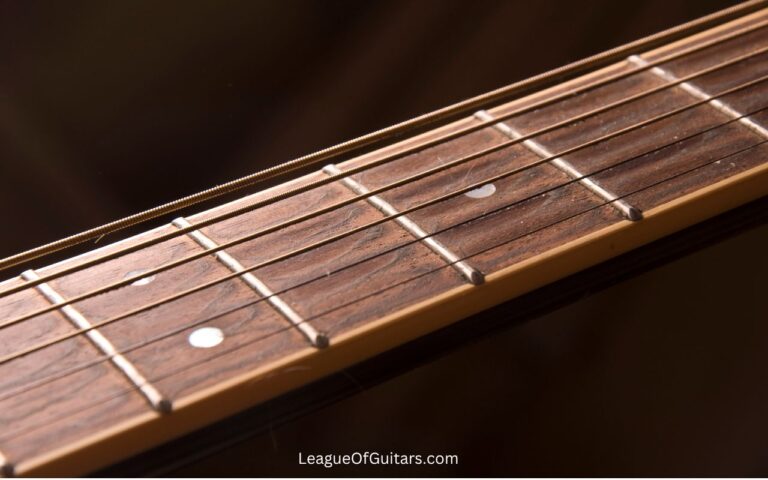
10. Tuning Pegs
Tuning pegs, also known as machine heads, are the small knobs located on the headstock of your guitar.
With the help of Tuning Pegs, you can loosen or tighten the strings, which in turn affects the pitch of each string.
Getting your tuning right is crucial for producing the right sound and making your music sound great! 🎵
Cheap or poorly-made tuning pegs can slip and cause your guitar to go out of tune easily, making it difficult to keep your instrument sounding its best.
High-quality tuning pegs can hold your strings in place firmly, ensuring that your guitar stays in tune for longer periods of time. 🔧
There are different types of tuning pegs, such as open-gear and sealed-gear pegs.
Open-gear pegs are the more traditional type, featuring an exposed gear mechanism that requires regular lubrication to maintain smooth operation.
Sealed-gear pegs are enclosed and self-lubricating, making them more resistant to dust and debris.
It’s also important to note that changing the type of tuning pegs on your guitar affects the weight and balance of your guitar.
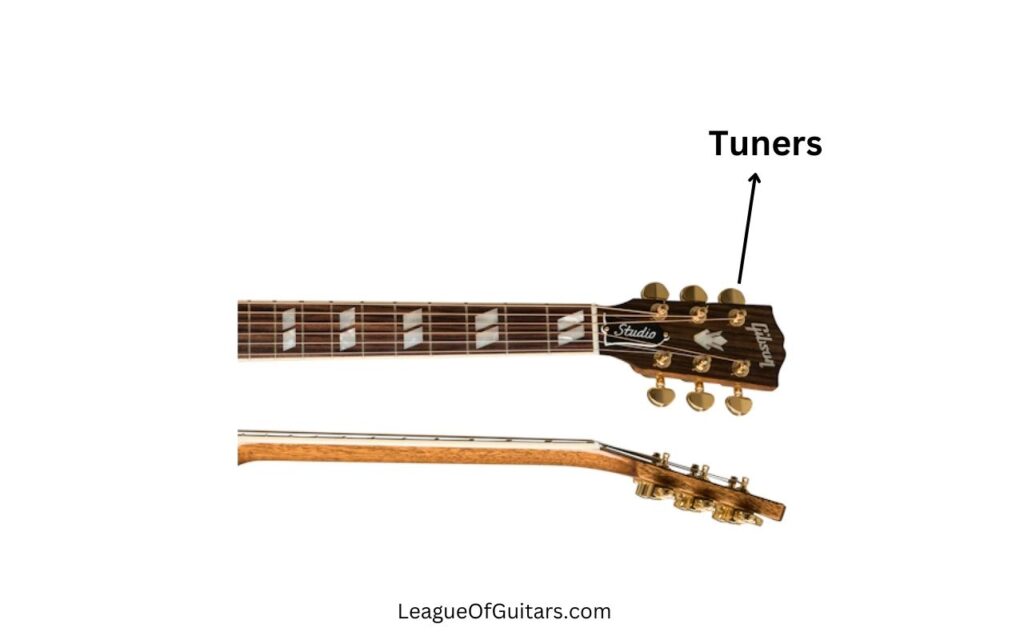
Final Words
Many things together contribute to the overall sound quality of the guitar. These include tonewood, tuners, pickups, strings, etc.
You will have to consider all of these ten things to buy a guitar that would sound the best and you will love and love it for years and years.
I hope that this blog was helpful to you and if you have any questions feel free to leave a comment down below.
FAQs
What are the key factors that influence the sound quality of a guitar?
The sound quality of a guitar is a complex interplay of various factors, including the type of wood used, the construction of the guitar, the strings, the pickups, and the electronics.
How does the type of wood affect the sound of a guitar?
Different types of wood have different tonal qualities. For instance, rosewood is known for its warm, rich tone, while maple produces a brighter, more cutting sound.
What is the role of guitar construction in shaping its sound?
The construction of a guitar, including the bracing and the thickness of the top, plays a significant role in determining its resonance and sustain.
How do strings impact the sound of a guitar?
The material, gauge, and tension of the strings can significantly affect the guitar’s tone, brightness, and overall sound character.
What are pickups and how do they influence the sound of an electric guitar?
Pickups are electromagnetic transducers that convert the vibrations of the strings into an electrical signal. The type, placement, and wiring of pickups greatly impact the tone and output of an electric guitar.
How does the electronics in an electric guitar affect its sound?
The electronics, including the potentiometers, capacitors, and switches, can further refine the tone and control the various aspects of the sound.
What are some of the most sought-after tonewoods for acoustic guitars?
Popular tonewoods for acoustic guitars include rosewood, maple, mahogany, and spruce. Each wood has its unique tonal characteristics.
What is the difference between solid-body and hollow-body electric guitars in terms of sound?
Solid-body electric guitars generally produce a more focused and sustain-rich sound, while hollow-body guitars offer a warmer, more resonant tone.
How does the gauge of guitar strings influence the sound?
Heavier gauge strings produce a fuller, richer sound with more sustain, while lighter gauge strings provide a brighter, more agile tone.
What are some common types of pickups for electric guitars and how do they differ in sound?
Single-coil pickups are known for their bright, jangly tone, while humbucking pickups provide a thicker, more powerful sound with reduced noise.
What are some of the factors that can affect the intonation of a guitar?
Intonation is the accuracy of the guitar’s notes across the fretboard. Factors like string gauge, neck relief, and bridge saddle placement can affect intonation.
